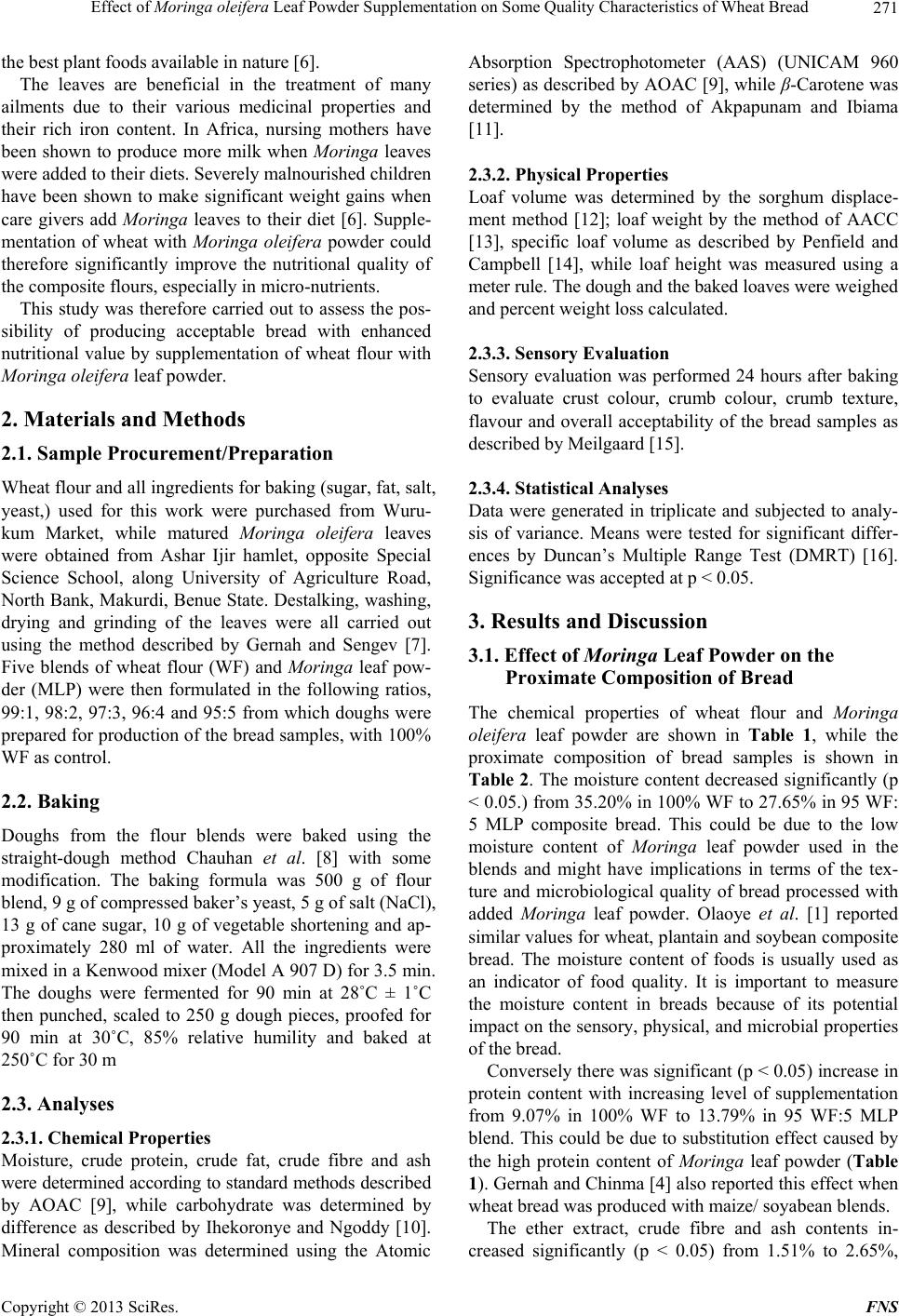
Effect of Moringa oleifera Leaf Powder Supplementation on Some Quality Characteristics of Wheat Bread 271
the best plant foods available in nature [6].
The leaves are beneficial in the treatment of many
ailments due to their various medicinal properties and
their rich iron content. In Africa, nursing mothers have
been shown to produce more milk when Moringa leaves
were added to their diets. Severely malnourish ed ch ildren
have been shown to make significant weight gains when
care givers add Moringa leaves to their diet [6]. Supple-
mentation of wheat with Moringa oleifera powder could
therefore significantly improve the nutritional quality of
the composite flours, especially in micro-nutrients.
This study was therefore carried out to assess the pos-
sibility of producing acceptable bread with enhanced
nutritional value by supplementation of wheat flour with
Moringa oleifera leaf powder.
2. Materials and Methods
2.1. Sample Procurement/Preparation
Wheat flour and all ingredients for baking (sugar, fat, salt,
yeast,) used for this work were purchased from Wuru-
kum Market, while matured Moringa oleifera leaves
were obtained from Ashar Ijir hamlet, opposite Special
Science School, along University of Agriculture Road,
North Bank, Makurdi, Ben ue State. Destalking, washing,
drying and grinding of the leaves were all carried out
using the method described by Gernah and Sengev [7].
Five blends of wheat flour (WF) and Morin ga leaf pow-
der (MLP) were then formulated in the following ratios,
99:1, 98:2, 97:3, 96:4 and 95:5 from which doughs were
prepared for production of the bread samples, with 100%
WF as co ntrol.
2.2. Baking
Doughs from the flour blends were baked using the
straight-dough method Chauhan et al. [8] with some
modification. The baking formula was 500 g of flour
blend, 9 g of compressed baker’s yeast, 5 g of salt (NaCl),
13 g of cane sugar, 10 g of vegetable shortening and ap-
proximately 280 ml of water. All the ingredients were
mixed in a Kenwood mixer (Model A 907 D) for 3.5 min.
The doughs were fermented for 90 min at 28˚C ± 1˚C
then punched, scaled to 250 g dough pieces, proofed for
90 min at 30˚C, 85% relative humility and baked at
250˚C for 30 m
2.3. Analyses
2.3.1. Chemical Properties
Moisture, crude protein, crude fat, crude fibre and ash
were determined according to standard methods describ ed
by AOAC [9], while carbohydrate was determined by
difference as described by Ihekoronye and Ngoddy [10].
Mineral composition was determined using the Atomic
Absorption Spectrophotometer (AAS) (UNICAM 960
series) as described by AOAC [9], while β-Carotene was
determined by the method of Akpapunam and Ibiama
[11].
2.3.2. P hysical Properties
Loaf volume was determined by the sorghum displace-
ment method [12]; loaf weight by the method of AACC
[13], specific loaf volume as described by Penfield and
Campbell [14], while loaf height was measured using a
meter rule. The dough and the baked loaves were we i g h ed
and percent weight loss calcu lated.
2.3.3. Sensory Evaluation
Sensory evaluation was performed 24 hours after baking
to evaluate crust colour, crumb colour, crumb texture,
flavour and overall acceptability of the bread samples as
described by Meilgaard [ 1 5].
2.3.4. Statistica l A na lyses
Data were generated in triplicate and subjected to analy-
sis of variance. Means were tested for significant differ-
ences by Duncan’s Multiple Range Test (DMRT) [16].
Significance was accepted at p < 0.05.
3. Results and Discussion
3.1. Effect of Moringa Leaf Powder on the
Proximate Composition of Bread
The chemical properties of wheat flour and Moring a
oleifera leaf powder are shown in Table 1, while the
proximate composition of bread samples is shown in
Table 2. The moisture content decreased significantly (p
< 0.05.) from 35.20% in 100% WF to 27.65% in 95 WF:
5 MLP composite bread. This could be due to the low
moisture content of Moringa leaf powder used in the
blends and might have implications in terms of the tex-
ture and microbiological quality of bread processed with
added Moringa leaf powder. Olaoye et al. [1] reported
similar values for wheat, plantain and soybean composite
bread. The moisture content of foods is usually used as
an indicator of food quality. It is important to measure
the moisture content in breads because of its potential
impact on the sensory, physical, and microbial properties
of the bread.
Conversely there was significant (p < 0.05) increase in
protein content with increasing level of supplementation
from 9.07% in 100% WF to 13.79% in 95 WF:5 MLP
blend. This could be due to substitution effect caused by
the high protein content of Moringa leaf powder (Table
1). Gernah and Chinma [4 ] also reported this effect when
wheat bread was produced with maize/ soyabean blends.
The ether extract, crude fibre and ash contents in-
creased significantly (p < 0.05) from 1.51% to 2.65%,
Copyright © 2013 SciRes. FNS